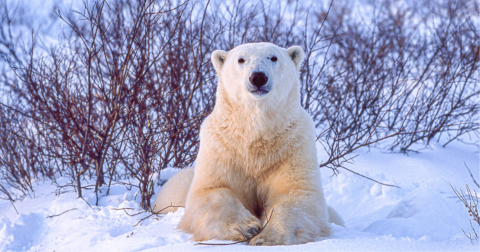Is New York City Getting its Composting Program Right?
Climate•10 min read
Explainer
We’re nearing or have already arrived at the 6th Great Extinction — only this time, the crisis is manmade.


Words by Björn Ólafsson
Climate change is far more than a problem for humanity. The vast majority of victims of heat waves, natural disasters, habitat change and other calamities will be non-human animals. In fact, we are nearing or have already arrived at the 6th Great Extinction, a period where animal species die off in record numbers — only this time, as a result of humanity, not natural phenomena. Right now, half of all species on Earth are experiencing population declines.
Despite this, most climate coverage tends to focus on human victims of climate change. In this article, we consider the furry, feathered or scaly animals who are also going to suffer. Here are the animals most affected by climate change, as well as what you need to know about how and why our changing environment will harm them.
Essentially all animals on Earth are affected by climate change and, due to the massive amounts of known and unknown species on the planet, it is difficult to rank them concretely. But that hasn’t stopped organizations from trying.
From the Center for Biological Diversity’s 350 Species threatened by Global Warming to the Audubon’s Birds and Climate reports, scientists across the world are cataloging the harm done to animals by climate change. Here are many groups of animals likely to face extinction or other harm as a result of human-driven changes to our environment.
Animal agriculture is contributing to climate change at a massive scale, responsible for between 11.1 and 19.6 percent of direct emissions and 40 percent of deforestation globally. But it goes the other way too: farmed animals like cows, pigs, chickens and goats are harmed under the increasing global temperatures.
Unlike other animals, farmed animals are unable to flee extreme weather events. Cows can die en masse from heat stroke or forest fires caused by high temperatures. What’s worse, being crowded together into factory farms gives these animals very little fresh air to cool off. Farmed animals, due to human intervention, are now far more common than wild animals. While farmed animals are unlikely to go extinct as long as humans are alive, they already suffer under climate change.
As climate change begins melting glaciers and upending life at Earth’s poles, animals in historically colder climates will suffer and die off. Animals in the Arctic and Antarctic regions (as well as other cold ecosystems) who are likely to become extinct or endangered include:
Insects are some of the animals most vulnerable to climate change, because they are extremely sensitive to temperature. If the Earth’s mean temperature increases to 3.2 degrees Celsius, almost half of all insects will see their natural ranges diminished. In one estimate based on limited populations, 65 percent of all insect species could go extinct due to climate change.
However, climate change may actually advantage certain insects like dragonflies and aphids, allowing them to thrive and even encroach on new territory, possibly causing harm to native flora and fauna, or spreading disease.
Some insects who are particularly vulnerable to climate change include:
Many animals are already near extinction due to habitat loss, from the cuddly Giant Panda to the massive Asian Elephant. It should be no surprise that climate change is likely to hasten their descent into extinction, unless humankind can restore their natural ecosystems in time. Some endangered animals who will be most impacted include:
The Earth’s oceans also feel the effects of climate change, with diminishing coral reef populations and water temperatures rising. It certainly doesn’t help that the industrial fishing industry is also already devastating fish populations across the world. Due to climate change and fishing, 60 percent of marine ecosystems are already degraded, and nearly 50 percent of marine species will be extinct — or near-extinct — by the end of the century.
Fish, who are known to pass the mirror sentience test and who feel pain, are likely to continue suffering in the wild, fleeing warmer waters for better chances of success in the far north or south.
Many habitats are under threat due to varying factors like desertification, erosion, glacial melting, flooding, forest fires and more. Unfortunately, areas rich in biodiversity — like the Amazon Rainforest, Madagascar and Southern China — are disproportionately susceptible to climate change. Over 54 percent of all of the Earth’s species are currently living in an area that will likely experience loss or fragmentation of habitat due to climate change.
Even if a species of animal is capable of surviving higher-temperature heat waves, their food sources may not. Plants are experiencing many climate-induced stressors — like novel pest and disease species, desertification, erosion, invasive plant species and saltwater intrusion — driven by rising temperatures. As plants start to die off in greater numbers, the animals that rely on them for food are likely to die as well, setting the entire food chain off-balance.
Extreme temperatures increase the likelihood of natural disasters, especially tropical storms and hurricanes. Warmer weather can increase the wind speeds in these natural events, lengthening their staying power and increasing their destruction. Monsoons, which are not natural disasters but periods of extreme rainfall in Southeast Asia, are also prone to being more erratic and stronger due to climate change.
Forest fires are also more likely in warmer temperatures, such as the 2019-2020 bushfire season in Australia, which destroyed an unprecedented 24 million hectares of land. Increasing amounts of these natural disasters can destroy the habitats of animals, kill animals outright and lead to further land degradation.
As habitats fragment and temperatures rise, animals will naturally seek better places to live. In one estimate, half of all species are already on the hunt for cooler places to call home. They almost always go north, which will lead to fewer animal species near the Equator, upsetting natural rhythms of the ecosystems.
In addition to forced migration, climate change is already altering seasonal migratory patterns of many animals who use temperature as a gauge for their movement. For example, salmon, who make a seasonal migration annually, naturally seek colder water. Thus, as colder water becomes less plentiful, they will have to continually seek out deeper streams and rivers to survive, changing their migration patterns and possibly lowering their species count.
As a result of these changing migratory patterns, animals and humans will come into closer and closer contact, especially near farms and other deforested areas. Many species, now in unfamiliar environments without a steady supply of food, may become more aggressive towards humans. These animals may become hunted en masse, causing further damage to ecosystems.
Pets and companion animals, like all animals, are affected by rising temperatures. Depending on where they live, dogs and cats may experience worse quality of life due to long heat waves. Pets who’ve historically lived in colder climates, like Husky dogs or Russian Blue cats, are particularly vulnerable to heat.
Pets will also deal with the indirect effects of heat: more invasive pest species and diseases. Climate change is helping pests survive in more temperate areas that household pets may also reside in. Every year, pests migrate about three kilometers farther from the Equator as the Earth’s temperature warms. Soon, it won’t be uncommon to see fungal diseases native to Latin America, or ticks from Sub-Saharan Africa, in countries in the far north.
It is difficult to imagine an animal species that is not affected by climate change. Even if the animal is able to bear higher temperatures without any trouble, their local environment is almost certainly changing. They are likely coping with new species migrating into their territory, environmental degradation or increased contact with humans.
While it is not possible to determine exactly how many animals die due to climate change alone (as climate change impacts animals in many direct and indirect ways), we can readily analyze how many animals are dying every year in this century compared to previous centuries.
Since the rise of humankind, we have witnessed an 85 percent decrease in the biomass of wild animals globally. According to the World Wildlife Fund, we’ve seen a 70 percent decrease in wild animals in the last half century alone. However, the overall mass of animals has actually increased, due to humanity’s massive system of animal agriculture, which raises and slaughters 83 billion animals a year.
The Earth has already started, or is about to start, the Sixth Great Extinction. This is the first Great Extinction caused by one species: humankind. We have already caused the extinction of between an estimated 7.5-13 percent of species before the year 1500 C.E., and many more will go extinct because of climate change.
Climate change is likely to wipe out many of the over 40,000 species on the IUCN Red List, a measure of endangered species. However, this list disproportionately examines mammals and birds, and disproportionately excludes invertebrates, who make up most species on Earth. The number of species affected by climate change is likely far higher than 40,000.
Climate change is far from the only form of environmental havoc humans are wreaking across the globe. We are heavily modifying the land, razing forests and clearing grasslands, primarily for agriculture — especially animal agriculture. Water and air pollution can poison animals, and habitats are eroded and degraded by water shortages.
While it is impossible for any one individual to stop climate change alone, people can contribute to global efforts to reduce carbon and methane emissions. Individuals can limit their carbon footprint most by reducing car and plane travel, as well as their consumption of meat and other animal products. They can also join with other climate action groups that fight for better regulation of fossil fuels and animal agriculture.